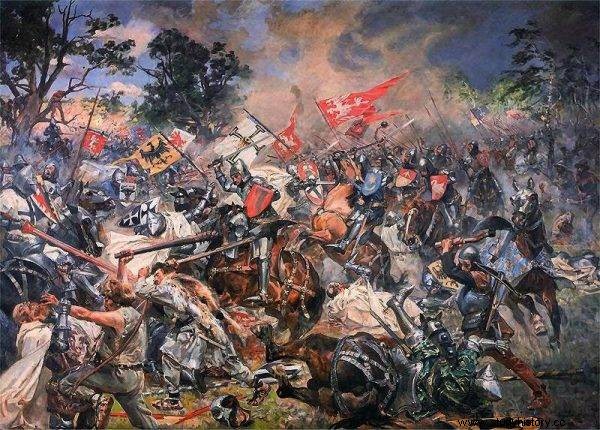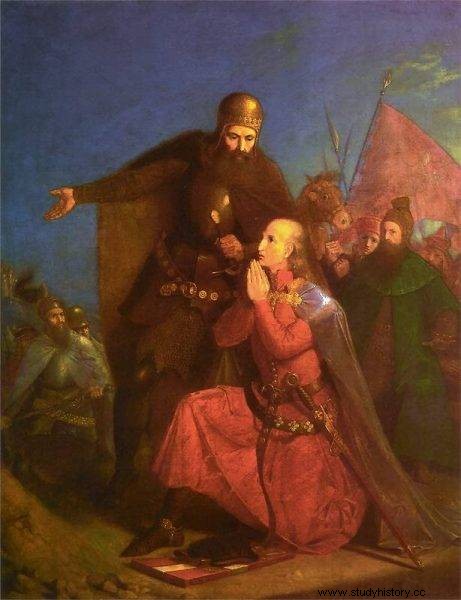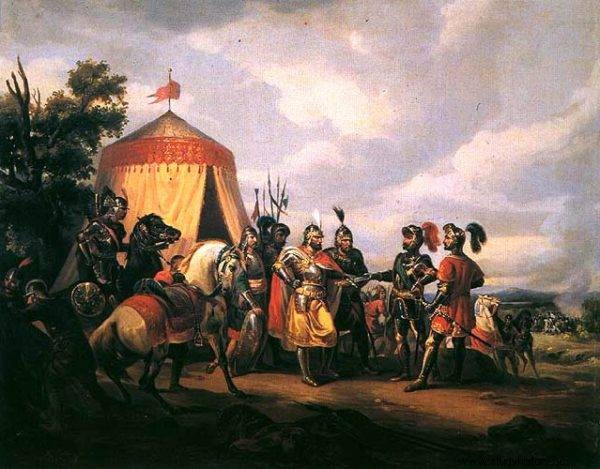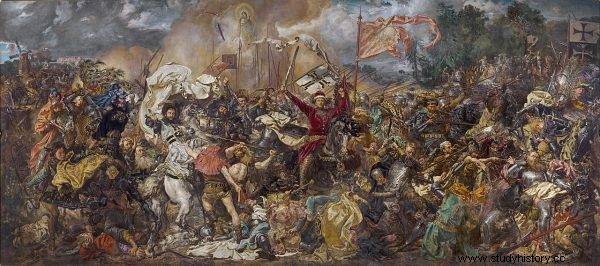The battle in the fields of Grunwald was inevitable. On July 15, 1410, Polish-Lithuanian troops stood against the Teutonic Knights. The world has not seen such a slaughter for a long time.
"Władysław, the king of Poland, considering that there was no hope of maintaining peace with the Teutonic Knights, called all the lords, knights and subjects of the Polish kingdom to arms and, by sending letters and summons, ordered a universal expedition to Prussia against the Teutonic Knights," wrote Jan Długosz. And although the chronicler, who was unfavorable to the Polish ruler, suggested that Władysław avoided an armed decision, when it happened, the world had not seen such a slaughter for a long time.
The battle in the fields of Grunwald was inevitable. From the moment when the Lithuanian prince Jogaila ascended the Polish throne in 1386, it was known that sooner or later his new state would have to face the power of the Teutonic Order . The introduction of over 100 years earlier the idea of bringing the Teutonic Knights to subjugate the Prussians - although good in assumption - turned out to be a failure. As a consequence, a strong state was created at the northern border of Poland, which became an even greater threat than the conglomeration of pagan tribes.
It was not changed even by the Polish-Lithuanian union agreement concluded in Krewo in 1385 . He only slightly eliminated the advantage of the monks' strength. And it was this "bit" that the new king Władysław Jagiełło wanted to use at all costs. When the Teutonic Knights reached what was to come, they had no choice but to set off to meet their destiny. Thus, in the morning of July 15, 1410, the two armies faced each other in the area of the village of Grunwald , Łodwigowo and Stębark.
Eagle with Pogoń
The number of troops mobilized by Władysław showed that he was not going to play with his opponent. He brought from the Crown 51 banners in the strength of nearly 20 thousand. driving, including about 1.5 thousand. of the hives. In turn, Grand Duke Witold managed to issue 40 banners, probably 10-11 thousand. Lithuanian, Ruthenian and Samogitian chivalry and light Tatar riding. These states also include the difficult to estimate number of infantry and several thousand armed henchmen, domestics and coachmen. As a result, it gave considerable strength to nearly 35 thousand. people.

photo:Artur Orlonow / CC BY-SA 3.0 The Lviv banner in the Battle of Grunwald
Ulryk von Jungingen briskly marched near Grunwald with an army of around 16,000 knightly cavalry organized in 51 banners. This number also included mercenary units and foreign guests of the order - perhaps tempted by the vision of a crusade against the "pagan" state of Jagiełło. Interestingly, despite the fact that the struggle was to be or not to be an order, the brothers themselves to the grand master were only 250 out of 570 active at that time. It should be assumed, however, that it was not fear for their lives that made them stay away from the battlefield, but an order to secure many castles in the Teutonic state. And just like in the case of the royal side, the Teutonic Knights also brought with them a crowd of several thousand armed auxiliary service and artillery (infantry should be guessed).
Therefore, not having as large mobilization possibilities as the Jagiełło family, the Order necessarily deployed an army that was numerically weaker - which did not mean that it was less dangerous. It must be remembered that the ranks of the Jagiełło army were usually supplied by Witold's troops with less armor. Besides, among the royal combatants there were also those who had to do without full plate armor.
Royal ranks
The historians' research suggests that despite the relatively efficient reconnaissance carried out by both sides, the meeting in the fields of Grunwald was a little surprise for them. Each of them expected an enemy coming from a different direction. Nevertheless, around noon, the opponents were basically ready for a general fight. They were separated by a small, almost 300-meter-long space of the valley, the so-called Great Stream.
Jagiełło's army, stretched approximately 3 km wide, faced the north-west. Their ranks partly coincided with the forest line stretching to the south-east of the villages of Łodwigowo and Stębark. The left wing was composed of Polish and mercenary knights from Bohemia, Moravia and Silesia. These forces were probably managed by the royal marshal Zbigniew of Brzezie. The right wing, on the other hand, consisted of the banners of the Grand Duchy of Lithuania and allied Tatar troops. Here prince Witold was in direct command.

The battle in the fields of Grunwald was inevitable
However, the whole thing was supervised by Władysław Jagiełło himself. The king with a few (60 knights?), but an excellent escort, probably took a place on a hill slightly at the back of the ranks , perhaps at the junction of the Crown and Lithuanian troops. From there, he could efficiently direct the battle. The troops stood in lines of flag columns arranged in several projections at a depth of 2-3 km.
The army of the grand master stood on a similar front, in terms of the width of the Jagiełłowa side, along the western upper edge of the Wielki Stream valley. Teutonic forces were also formed in columns, but with a smaller depth of subsequent projections. In the intervals between the banners of the first line, the guns were placed which Ulryk seems to have counted on very much. On the other hand, the fairy tales should include old tales of pits and other stratagems with which the Teutonic Knights were to surprise the Polish-Lithuanian army. Time is needed for such works, and the Teutonic Knights simply did not have that.
The head does not hurt since the tabernacle
The customary knightly fights that lasted from the morning in the foreground seemed to go on forever. Meanwhile, in the Polish camp King Władysław put on an armor, but in it ... he confessed, listened to two masses and dressed many knights . Finally, impatient with the anticipation in the July sun, the Grand Master took action. However, wishing to maintain the appearance of a chivalrous ethos, he sent his emissaries to the king with the customary challenge to battle in the form of two naked swords. At the same time, the deputies conveyed the Grand Master's readiness to withdraw the Teutonic ranks, "as long as he could get you to fight [...] so that you would not delay the battle". Jagiełło calmly accepted both the impudent tone of the deputy's message and the swords given to him. After all, the head doesn't hurt since the sanctuary.

Władysław donned armor, but in it he… confessed.
And indeed, as announced, the Teutonic ranks retreated by several dozen meters. Thus, although they had the height advantage of their positions anyway, they forced the attacking union forces to additional effort during a longer climb up the slope of the Great Stream valley. Otherwise, armed troops might have collided almost in the middle of the valley.
This time the king did not delay any longer, but ordered the attack. With the sound of trumpets and after singing Theotokos the right wing of the allies, made up of Lithuanian regiments supported by several crown banners, advanced to attack. It is not fully known what caused this advancement of the Witold army - whether by his impetuosity or deliberate action. Nevertheless, immediately after them, the Polish flags also started fighting and mercenary.
Get out?
The Teutonic Knights, seeing the approaching allied troops, fired their cannons twice, but did not cause any damage to the attackers. Then they themselves charged back. The momentum of the Polish-Lithuanian attack was big enough that despite the elongated ascent along the valley slope the royal banners managed to contain the onslaught of the Teutonic Knights and then throw them a few hundred meters and get the guns .
After almost an hour of struggle on the Witold wing, a crisis appeared. Initially surprised by the violence of the Lithuanian attack the Teutonic Knights gathered themselves up and, probably using the banners of another throw, began to take the initiative. At one point, the less armed Lithuanians and Russians ran away. Fortunately, the retreat, considered by some to be a sham, had one positive effect. She joined considerable religious forces in pursuit of refugees, including even the crown banner of Czech-Moravian burglars.

The king did not delay any longer, he ordered the attack
However, not all of Witold's forces gave the rear. Commanded by the royal brother of Prince Semen Lingwen the 3 Smolensk banners remained in position and at the cost of enormous losses closed the mutilated flank of the Crown forces. Soon, a great Krakow banner appeared there, and together with Sandomierz, Wieluń and Halicka it stopped the growing pressure of the Teutonic Knights returning from the pursuit of Vytautas' troops. Nay. When some of the Lithuanian-Ruthenian refugees felt that the momentum of the Teutonic pursuit was weakening, they immediately turned back and ran into the scattered enemy troops. The crown units from the next throws probably also joined the action.
Banner in danger!
Although the king managed to recreate the right wing of his troops, it was still a long way from success. The pressure of the monastic troops did not diminish at all. The Grand Master threw another banners into battle, personally leading his knights' charges several times. Perhaps it was during one of them fell to the ground a great banner with a white eagle in a crown on a red field - the symbol of the Crown and the main landmark of knighthood on the battlefield. The Teutonic Knights already felt themselves victorious and were even supposed to sing the triumphant song Crist ist entstandin.
However, they did not enjoy this success for a long time, as reserves pushed by the king soon came to the rescue of the endangered flagship. The Kingdom banner was quickly raised, and Jagiełło's forces gradually began to take over the Teutonic Knights on the entire front. Finally, exhausted by the fight, the religious troops began to retreat towards their own camp.
The Grand Master strikes back
Ulryk, despite the fact that he took an active part in the fight, was well aware of the seriousness of the situation along the entire line of fights. Seeing this, around At 15.00 he made one more attempt to avert the defeat. Having collected 16 intact or still warable banners, he set off, heading east first, then turning right to threaten the newly reconstructed right flank of the royal troops.
Before this happened, however, the battle could have ended with a Teutonic victory much earlier. For, leading his reserve, the Grand Master at one point found himself near Jagiełło's position. Fortunately, Ulric was not interested in the king's little escort. One of his knights, Dypold von Kökeritz, had a different opinion. Tempted by the splendor of the royal armor, although he probably did not know who owned it, he set off for a truly tournament clash. Jagiełło seemed to be prepared to receive the strike, but before it happened, Zbigniew from Oleśnica did him, knocking the German to the ground . The stunned impudent was to be struck by the king himself, and by his escort and soldiers on foot.

Battle of Grunwald
The erratic maneuver was ingenious. Made too slowly, however, to completely surprise the royal forces. It is true that for a moment the Polish knights took the incoming riders for the Lithuanians returning from the escape but quickly realized the mistake. As a result, the speeding mass of 3 thousand. knights of the Order attacked the right-wing Polish troops prepared for battle . The attack of the Teutonic Knights was opposed first by the court banner, then by the great Krakow banner, and behind it by others, which until then had remained in reserve. The result of the clash turned out to be tragic for the attackers. And among the fallen was the great master himself. Simultaneously with the defeat of Ulric's last charge, all his forces found themselves trapped. From the side of Łodwigów, the pressure of the Polish knights was sustained, and from the side of Stębark, the masses of the Lithuanian cavalry advanced, intoxicated with the victory over the pursuit units of the monks.
Hekatomba
After the Teutonic forces were crushed in the field, their camp was stormed, probably surrounded by carts. The exhausted knights from the broken banners of the Order defended themselves bravely, but briefly. Most of the defenders have been cut down or taken prisoner, and the rich caravans fell prey to the victors. Those who managed to escape the pogrom looked for help in a panic escape towards Malbork. Few, however, got there, because on the way they died under the swords of the Polish-Lithuanian pursuit or in numerous swamps and water obstacles.
The defeat of the law was complete. Up to 8,000 people lay their heads in the Grunwald field. knights, squires and henchmen, including as many as 203 religious brothers. To this should be added about 1 thousand. the captured knights and probably even more camp domestics. In total, the order could lose 10-12 thousand. people, which accounted for 70-80% of all forces at his disposal on the morning of July 15. Korona's losses turned out to be unexpectedly small. According to reports, the command had only 12 more significant knights and probably 500-600 people of more modest origin . The Lithuanian side, whose losses are estimated at several thousand knights and warriors, had to pay a much greater blood tribute.
The news of the defeat of Grunwald initially introduced chaos in the Teutonic state. Some towns and castles revolted against the monks and surrendered without a fight to Jagiełło's army going to Malbork. Unfortunately, the Teutonic capital was not captured. And the changing political climate in Europe to the detriment of the union made it necessary to think about making peace.
Bibliography
- Bishop M., Wars of Poland with the Teutonic Order 1308–1521 , Gdańsk 1993.
- Długosz J., The Battle of Grunwald (from the history of Poland) , comp. J. Dąbrowski, Krakow 1925.
- Chronicle of the conflict of Władysław the king a Polish with Teutonic Knights in the Year of Our Lord 1410 , crowd. J. Danka, A. Nadolski, Olsztyn 1984.
- Krzyżaniakowa J., Ochmański J., Władysław II Jagiełło , Wrocław 2006.
- Mikołajczak W., Grunwald 1410. One step away from defeat , Zakrzewo 2015.
- Nadolski A., Grunwald 1410 , Warsaw 1993.
- Nadolski A., Grunwald. Problems selected , Wodzisław Śląski 2010.
- Podhorodecki L., Famous Battles of Poles , Warsaw 1997.
- Wolski K., Polish battlefields in the light of archeology , Racibórz 2008.
